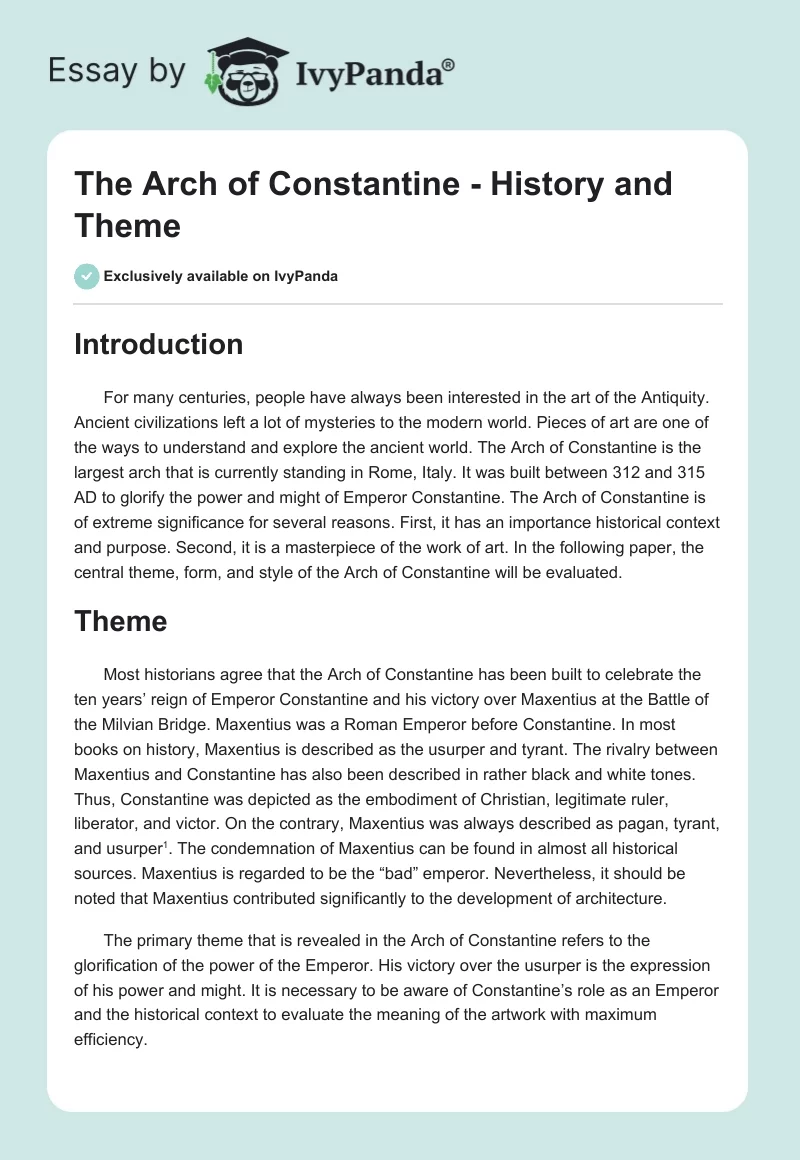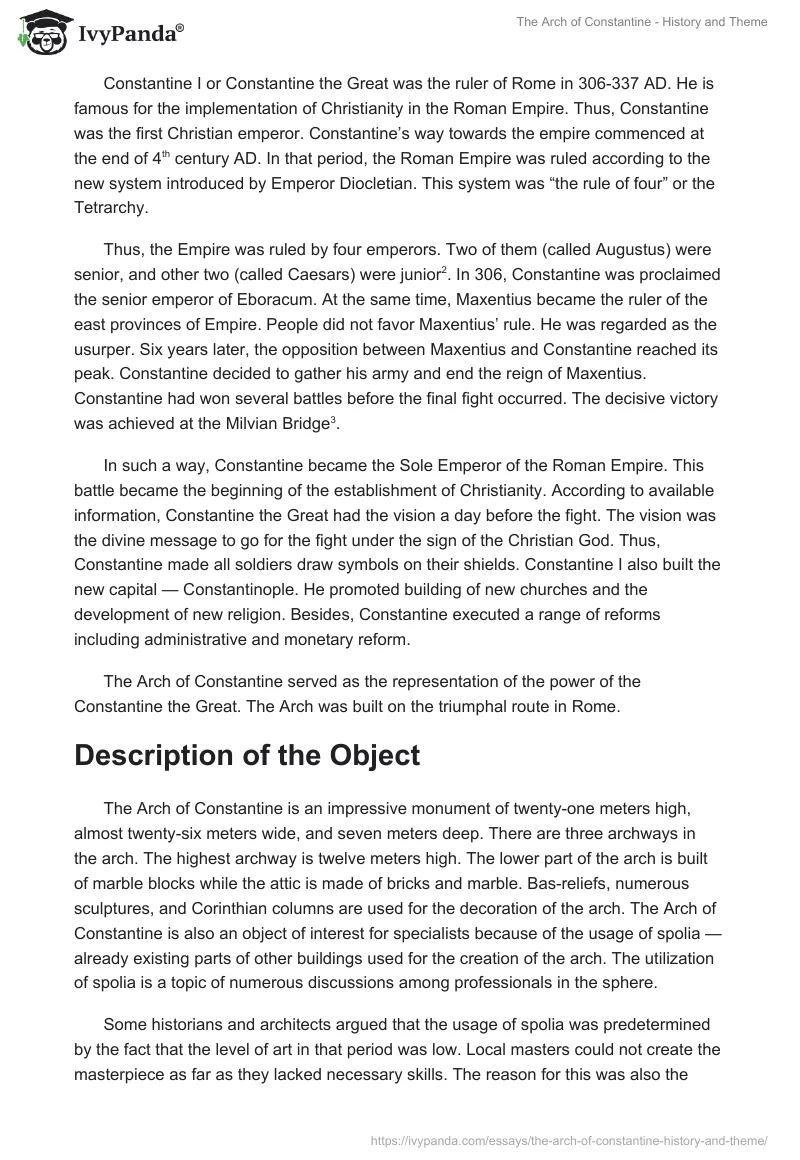Introduction
For many centuries, people have always been interested in the art of the Antiquity. Ancient civilizations left a lot of mysteries to the modern world. Pieces of art are one of the ways to understand and explore the ancient world. The Arch of Constantine is the largest arch that is currently standing in Rome, Italy. It was built between 312 and 315 AD to glorify the power and might of Emperor Constantine.
The Arch of Constantine is of extreme significance for several reasons. First, it has an importance historical context and purpose. Second, it is a masterpiece of the work of art. In the following paper, the central theme, form, and style of the Arch of Constantine will be evaluated.
Theme
Most historians agree that the Arch of Constantine has been built to celebrate the ten years’ reign of Emperor Constantine and his victory over Maxentius at the Battle of the Milvian Bridge. Maxentius was a Roman Emperor before Constantine. In most books on history, Maxentius is described as the usurper and tyrant. The rivalry between Maxentius and Constantine has also been described in rather black and white tones. Thus, Constantine was depicted as the embodiment of Christian, legitimate ruler, liberator, and victor.
On the contrary, Maxentius was always described as pagan, tyrant, and usurper. The condemnation of Maxentius can be found in almost all historical sources. Maxentius is regarded to be the “bad” emperor. Nevertheless, it should be noted that Maxentius contributed significantly to the development of architecture.
The primary theme that is revealed in the Arch of Constantine refers to the glorification of the power of the Emperor. His victory over the usurper is the expression of his power and might. It is necessary to be aware of Constantine’s role as an Emperor and the historical context to evaluate the meaning of the artwork with maximum efficiency.
Constantine I or Constantine the Great was the ruler of Rome in 306-337 AD. He is famous for the implementation of Christianity in the Roman Empire. Thus, Constantine was the first Christian emperor. Constantine’s way towards the empire commenced at the end of 4th century AD. In that period, the Roman Empire was ruled according to the new system introduced by Emperor Diocletian. This system was “the rule of four” or the Tetrarchy.
Thus, the Empire was ruled by four emperors. Two of them (called Augustus) were senior, and other two (called Caesars) were junior. In 306, Constantine was proclaimed the senior emperor of Eboracum. At the same time, Maxentius became the ruler of the east provinces of Empire. People did not favor Maxentius’ rule. He was regarded as the usurper. Six years later, the opposition between Maxentius and Constantine reached its peak. Constantine decided to gather his army and end the reign of Maxentius. Constantine had won several battles before the final fight occurred. The decisive victory was achieved at the Milvian Bridge.
In such a way, Constantine became the Sole Emperor of the Roman Empire. This battle became the beginning of the establishment of Christianity. According to available information, Constantine the Great had the vision a day before the fight. The vision was the divine message to go for the fight under the sign of the Christian God. Thus, Constantine made all soldiers draw symbols on their shields.
Constantine I also built the new capital — Constantinople. He promoted building of new churches and the development of new religion. Besides, Constantine executed a range of reforms including administrative and monetary reform. The Arch of Constantine served as the representation of the power of the Constantine the Great. The Arch was built on the triumphal route in Rome.
Description of the Object
The Arch of Constantine is an impressive monument of twenty-one meters high, almost twenty-six meters wide, and seven meters deep. There are three archways in the arch. The highest archway is twelve meters high. The lower part of the arch is built of marble blocks while the attic is made of bricks and marble.
Bas-reliefs, numerous sculptures, and Corinthian columns are used for the decoration of the arch. The Arch of Constantine is also an object of interest for specialists because of the usage of spolia — already existing parts of other buildings used for the creation of the arch. The utilization of spolia is a topic of numerous discussions among professionals in the sphere.
Some historians and architects argued that the usage of spolia was predetermined by the fact that the level of art in that period was low. Local masters could not create the masterpiece as far as they lacked necessary skills. The reason for this was also the new era. The arch was built in the period of the Late Antiquity and the beginning of Medieval Times. However, there are opinions that spolia have been used for the particular purpose.
The primary function of spolia is to represent the juxtaposition of different times. Spolia should serve as reminders of what has changed in the life of Roman Empire. Spolia of three Roman Emperors have been used in the arch: Hadrian, Trajan, and Marcus Aurelius. Spolia depict the history of the glorifying rule of these emperors. It is interesting to note that heads of rulers were replaced with the head of Constantine. In such a way, the Emperor demonstrated his significance for the overall history of the Roman Empire.
The first component of the arch is taken from the Great Trajanic Frieze. Two panels depict the battle of Trajan against barbarians. Scenes are rather idealized as far as they lack realistic elements. Eight medallions represent the second set of spolia that is devoted to Hadrian. Hunting scenes and further sacrifices are presented in medallions. The head of Constantine is used instead of Hadrian’s one. Aurelian panels are the third set of spolia. Scenes show the process of war including initial preparation and victory. All these spolia should be regarded as masterpieces of the Ancient art. The style of Constantine’s elements is rather different.
It is plainer and less detailed in comparison to previous pieces. Constantine’s frieze depicts the story of his victory of Maxentius. Every stage of the event is included. Thus, there is the scene of the departure to war, battles at Verona and the Milvian Bridge. Two last scenes depict Constantine among citizens. Also, Constantine is placed between people, and everyone looks at him. This representation resembles elements of the Last Supper. This scene is symbolic. It is used for the proclamation of the new era of governance — governance that is based on compassion rather than on tyranny.
The Patron of the Arch was Constantine himself. The primary purpose for the creation of the Arch was sending a particular message to other people about his greatness and power. Scholars agreed that Constantine was the first emperor who extensively used spolia. Longfellow describes the efficiency of this patronage. He writes, “The transfer of reliefs to this arch, the substitutions of Constantine’s portrait for those of the second-century “good” emperors, and the juxtaposition of old reliefs with new ones in which Constantine is acting as a strong and beneficent emperor all relentlessly establish Constantine as rightful heir to imperial tradition and legacy.”
Comparison
Abu Simbel is taken as an example for comparison with the Arch of Constantine. Abu Simbel is a complex of two temples. The Great Temple depicts Ramesses II at his throne. Works of art under comparison belong to difficult eras. Thus, Abu Simbel was built in 1279-1213 BC.
Despite different ages, both works were made during the life and reign of leaders. Form, style, and material of Abu Simbel is remarkably dissimilar. It was carved out in sandstone cliff and depicted the artistic traditions of the Egyptian art. Nevertheless, there is a similarity in patronage and function of both the Arch of Constantine and the Great Temple. Abu Simbel depicts Ramesses II sitting on his throne and other gods. Defeated enemies are presented beneath. There are also various statues that symbolize power and might.
The similar distinctive feature refers to the depiction of Ramesses’ greatest victory. Thus, it is seen that despite different epochs and styles, both works of art glorify leaders during their lives. Both masterpieces depict significant moments of reigns of rulers such as famous battles. Finally, religious signs are used in both Abu Simbel and the Arch of Constantine. While there is a variety of religious symbols in Abu Simbel, they are rather concealed in the Arch of Constantine (the position of Constantine is the same as that of Jesus on the Last Supper).
Conclusion
The Arch of Constantine was built to deify the reign of Constantine — the first Christian Emperor of Rome. Constantine united the Roman Empire and established Christianity. He was a democratic and powerful leader. The Arch of Constantine presents a juxtaposition of epochs via the usage of spolia. The Arch of Constantine may be compared to Abu Simbel’s Great Temple of Ramesses II. Both masterpieces depict the most significant victories of rulers and their power.
Bibliography
Ferris, Iain. The Arch of Constantine. Struod: Amberley Publishing Limited, 2014. Web.
Longfellow, Brenda. Roman Imperialism and Civic Patronage. Cambridge: Cambridge University Press, 2011. Web.
Mark, Joshua. “Abu Simbel.” Ancient History Encyclopedia. Web.
Varner, Eric. Maxentius, Constantine, and Hadrian: Images and Expropriation of Imperial Identity, Edited by Stine Birk, Myrup Kristensen, Birte Poulsen. Oxford: Oxbow Books, 2014. Web.
Vizzutti, Marcus. “The Arch of Constantine: A Tool of Propaganda and Change for the Roman Empire.” Art History Presentation Archive. Web.


